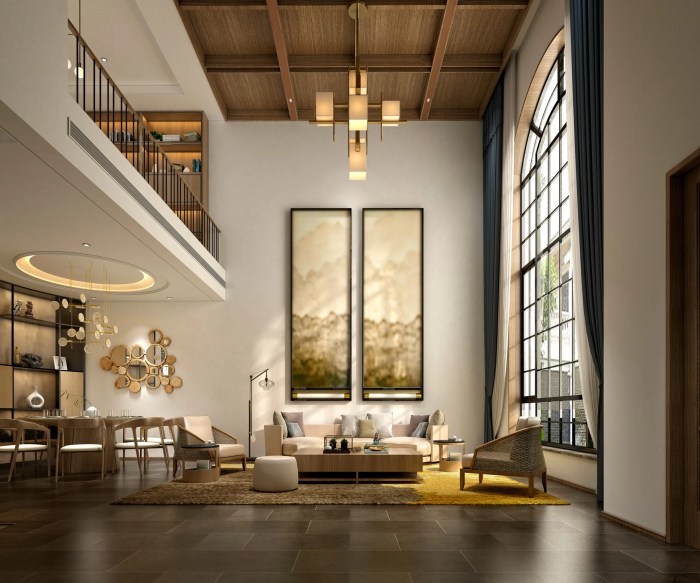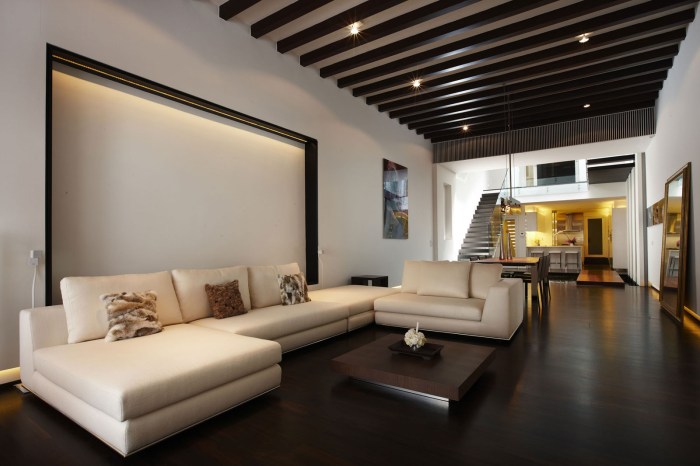Interior architecture sets the stage for this enthralling narrative, offering readers a glimpse into a story that is rich in detail and brimming with originality. From the fundamental concepts to the intricate design elements, the realm of interior architecture is a captivating blend of creativity and functionality.
What is Interior Architecture?
Interior architecture refers to the design and organization of interior spaces in a way that enhances the functionality, aesthetic appeal, and overall experience of the occupants. It involves the manipulation of spatial volume, surface treatment, lighting, and furniture to create an environment that is both practical and visually pleasing.
Difference between Interior Design and Interior Architecture
Interior design focuses primarily on the selection and arrangement of furniture, finishes, and decorative elements within a space to achieve a desired look or style. On the other hand, interior architecture goes beyond aesthetics to consider the structural elements of a space, such as walls, ceilings, and floors, and how they can be altered or enhanced to improve the overall design and functionality.
Examples of How Interior Architecture Impacts Spaces
- Space Planning: Interior architects carefully plan the layout of a space to ensure optimal flow and functionality. This can involve reconfiguring walls, creating partitions, or adding built-in furniture to maximize the use of space.
- Lighting Design: Interior architects design lighting schemes that not only illuminate a space but also enhance its ambiance and mood. This can include the use of natural light, artificial lighting fixtures, and controls to create different lighting effects.
- Material Selection: Interior architects choose materials for surfaces, finishes, and furniture that are not only visually appealing but also durable, sustainable, and suitable for the intended use of the space. This can include considerations for acoustics, maintenance, and environmental impact.
Elements of Interior Architecture

Interior architecture is defined by various key elements that contribute to the overall design and functionality of a space. These elements work together to create a cohesive and aesthetically pleasing environment that meets the needs of its users.
Role of Materials
Materials play a crucial role in interior architecture as they determine the texture, color, and overall feel of a space. The choice of materials can impact the durability, acoustics, and maintenance of the interior design. For example, using natural materials like wood and stone can create a warm and inviting atmosphere, while glass and metal can give a more modern and sleek look.
Lighting Design Influence
Lighting design is an essential aspect of interior architecture as it can dramatically transform the mood and functionality of a space. Proper lighting can highlight architectural features, create ambiance, and enhance the overall design aesthetic. Different types of lighting, such as ambient, task, and accent lighting, are used strategically to illuminate various areas and create a visually appealing environment.
Spatial Planning in Interior Architecture
Spatial planning is a critical aspect of interior architecture that involves organizing and arranging spaces to optimize functionality, efficiency, and aesthetics within a built environment. It is essential for creating harmonious and user-friendly interiors that meet the needs and preferences of the occupants.
Circulation and flow play a vital role in interior architectural design as they determine how people move through and interact with a space. By carefully considering circulation patterns, designers can ensure a smooth and intuitive flow that enhances the overall user experience.
This involves strategically placing elements such as doors, hallways, and furniture to facilitate movement and create a sense of openness and connectivity.
Examples of Innovative Spatial Planning Solutions
- Flexible Modular Design: Utilizing adaptable furniture and partitions that can be easily reconfigured to accommodate different activities and spatial requirements.
- Zoning Strategies: Implementing zoning techniques to delineate areas for specific functions, such as work zones, relaxation zones, and social zones, to enhance efficiency and organization.
- Multifunctional Spaces: Designing multipurpose areas that serve multiple functions, such as a living room that can also function as a guest bedroom or a workspace that transforms into a dining area, maximizing the utility of limited space.
- Vertical Spatial Planning: Leveraging vertical space through mezzanines, loft areas, or double-height ceilings to create visual interest, increase storage capacity, and expand usable square footage.
Sustainable Practices in Interior Architecture

Interior architecture plays a crucial role in sustainable design practices, aiming to create spaces that are environmentally friendly and energy-efficient. By incorporating sustainable principles into interior design projects, designers can reduce the environmental impact of buildings and promote healthier living spaces.
Use of Eco-Friendly Materials
Using eco-friendly materials is a key aspect of sustainable interior architecture. Designers opt for materials that are renewable, recyclable, and non-toxic to minimize the carbon footprint of a project
Integration of Energy-Efficient Systems
Incorporating energy-efficient systems is another sustainable practice in interior architecture. Designers utilize technologies such as LED lighting, smart thermostats, and daylight harvesting to reduce energy consumption and enhance the overall sustainability of a space. By optimizing natural light and ventilation, interior architects can create a comfortable and eco-friendly environment for occupants.
Waste Reduction and Recycling
Waste reduction and recycling are essential components of sustainable interior architecture. Designers focus on minimizing construction waste by repurposing materials and implementing recycling programs. By sourcing locally and reusing existing elements whenever possible, interior architects can contribute to a more circular economy and reduce the environmental impact of their projects.
Biophilic Design Principles
Biophilic design principles involve incorporating elements of nature into interior spaces to enhance occupant well-being and connection to the environment. By integrating plants, natural textures, and organic shapes, interior architects can create spaces that promote mental health, productivity, and overall satisfaction.
Biophilic design not only improves the aesthetic appeal of a space but also contributes to its sustainability by fostering a deeper relationship with the natural world.
Technology Integration in Interior Architecture
Technology plays a crucial role in modern interior architecture, revolutionizing the way spaces are designed and experienced. Integrating technology into interior architectural designs enhances functionality, aesthetics, and sustainability, ultimately transforming the user experience.
Impact of Smart Home Systems on Interior Architecture
Smart home systems have significantly influenced interior architecture by providing innovative solutions for automation, security, and energy efficiency. These systems enable users to control various aspects of their interior spaces remotely, such as lighting, temperature, and security, enhancing convenience and comfort.
For example, smart thermostats can adjust room temperatures based on occupancy, optimizing energy usage and creating a more comfortable environment.
Examples of How Technology Enhances the User Experience in Interior Spaces
1. Interactive Displays
Incorporating interactive displays in interior spaces allows users to engage with information, entertainment, or art in a dynamic way. For instance, interactive digital walls can change patterns or colors based on user interactions, creating a personalized experience.
2. IoT Devices
Internet of Things (IoT) devices such as smart speakers, sensors, and cameras can be seamlessly integrated into interior architecture to enhance functionality and connectivity. These devices enable users to control lighting, music, and security systems through voice commands or smartphone apps, improving convenience and accessibility.
3. Virtual Reality (VR) and Augmented Reality (AR)
VR and AR technologies are increasingly being used in interior architecture to visualize designs and simulate spaces before construction. These immersive technologies allow users to experience a space in a realistic manner, helping designers and clients make informed decisions and adjustments to the design.Overall, the integration of technology in interior architecture not only enhances the aesthetic appeal of spaces but also improves efficiency, sustainability, and user experience.
By embracing innovative technologies, interior designers can create dynamic and interactive environments that cater to the evolving needs of users.
Final Conclusion

As we conclude this exploration of interior architecture, we reflect on the intricate balance between aesthetics and practicality that defines this field. From sustainable practices to cutting-edge technology integration, the evolving landscape of interior architecture continues to shape the way we experience and interact with built environments.
Expert Answers
What is the difference between interior architecture and interior design?
Interior architecture focuses on the structural elements of a space, such as layout and spatial planning, while interior design deals more with the aesthetics and decor.
How does lighting design influence interior architectural spaces?
Lighting design plays a crucial role in enhancing the mood, functionality, and overall ambiance of interior architectural spaces.
Why is sustainable design significant in interior architecture?
Sustainable design in interior architecture reduces environmental impact, promotes healthier spaces, and supports long-term resource efficiency.
How is technology integrated into interior architectural designs?
Technology is integrated through smart home systems, interactive elements, and innovative solutions to enhance user experience and efficiency in interior spaces.
















